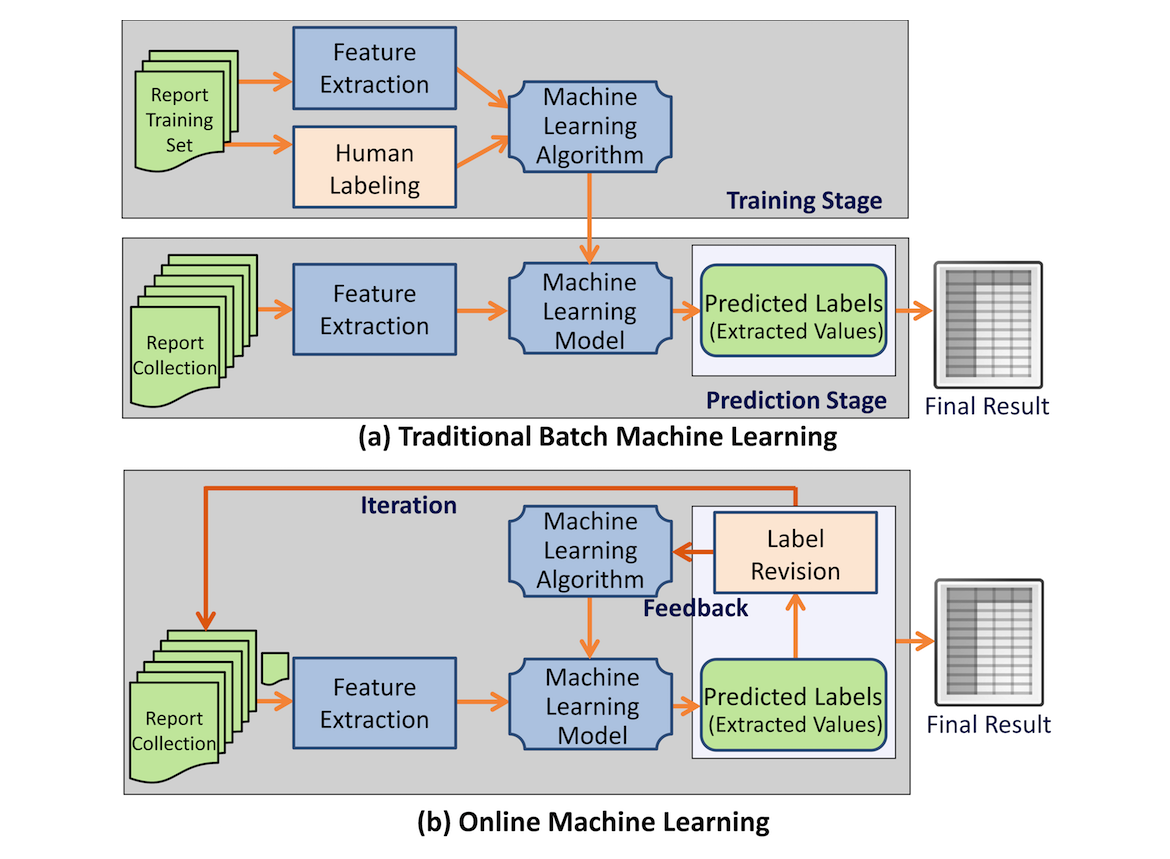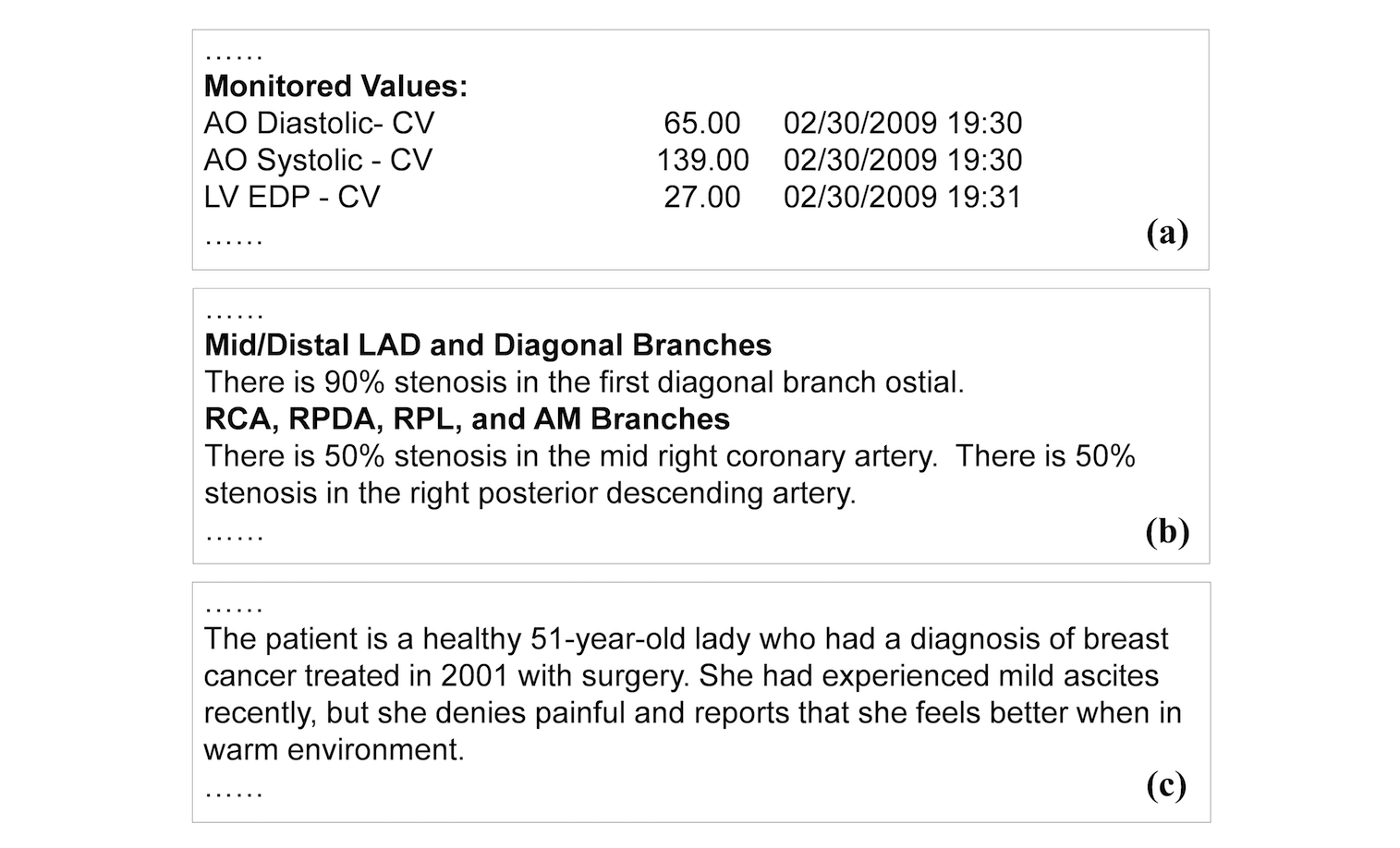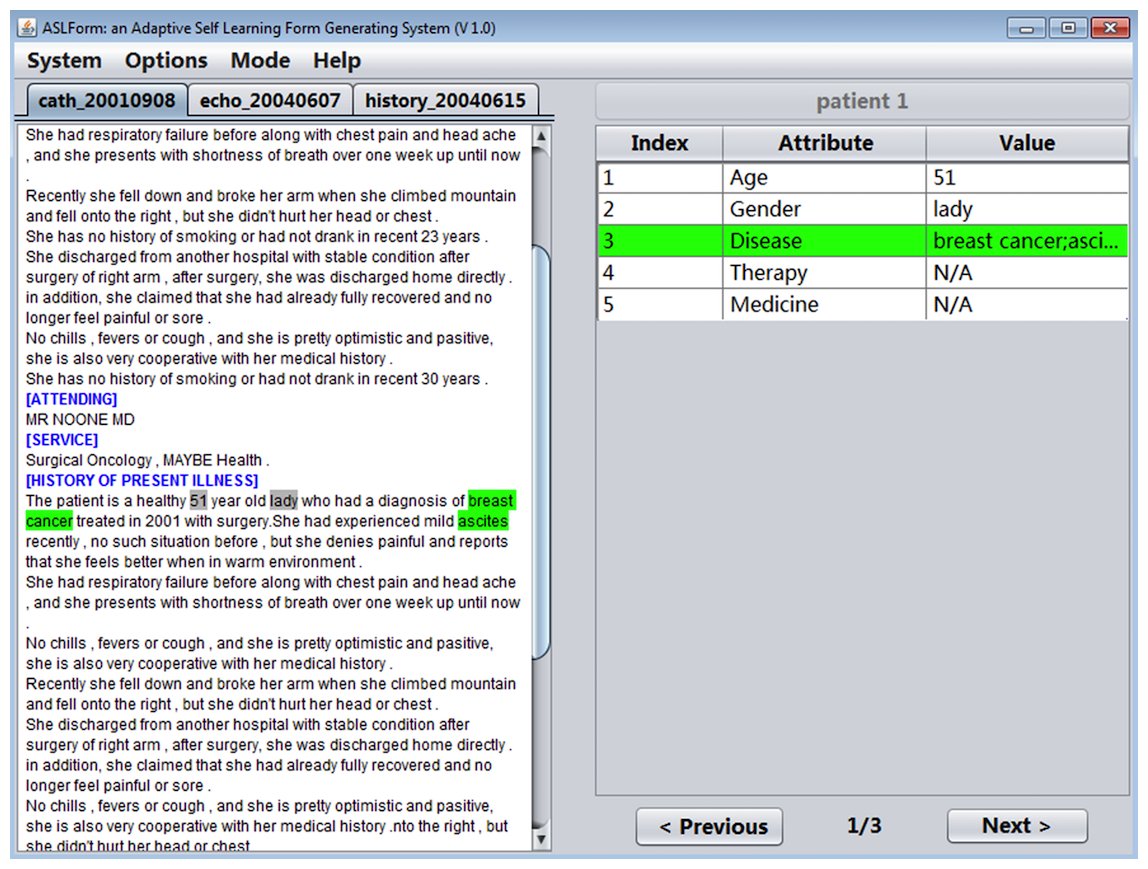Journal:Effective information extraction framework for heterogeneous clinical reports using online machine learning and controlled vocabularies
| Full article title | Effective information extraction framework for heterogeneous clinical reports using online machine learning and controlled vocabularies |
|---|---|
| Journal | JMIR Medical Informatics |
| Author(s) | Zheng, Shuai; Lu, James. J.; Ghasemzadeh, Nima; Hayek, Salim S.; Quyyumi, Arshed, A.; Wang, Fusheng |
| Author affiliation(s) | Emory University, Stony Brook University |
| Primary contact | Email: fusheng dot wang at stonybrook dot edu; Phone: 1 6316327528 |
| Editors | Eysenbach, G. |
| Year published | 2017 |
| Volume and issue | 5 (2) |
| Page(s) | e12 |
| DOI | 10.2196/medinform.7235 |
| ISSN | 2291-9694 |
| Distribution license | Creative Commons Attribution 2.0 |
| Website | http://medinform.jmir.org/2017/2/e12/ |
| Download | http://medinform.jmir.org/2017/2/e12/pdf (PDF) |
|
|
This article should not be considered complete until this message box has been removed. This is a work in progress. |
Abstract
Background: Extracting structured data from narrated medical reports is challenged by the complexity of heterogeneous structures and vocabularies and often requires significant manual effort. Traditional machine-based approaches lack the capability to take user feedback for improving the extraction algorithm in real time.
Objective: Our goal was to provide a generic information extraction framework that can support diverse clinical reports and enables a dynamic interaction between a human and a machine that produces highly accurate results.
Methods: A clinical information extraction system IDEAL-X has been built on top of online machine learning. It processes one document at a time, and user interactions are recorded as feedback to update the learning model in real time. The updated model is used to predict values for extraction in subsequent documents. Once prediction accuracy reaches a user-acceptable threshold, the remaining documents may be batch processed. A customizable controlled vocabulary may be used to support extraction.
Results: Three datasets were used for experiments based on report styles: 100 cardiac catheterization procedure reports, 100 coronary angiographic reports, and 100 integrated reports — each combines history and physical report, discharge summary, outpatient clinic notes, outpatient clinic letter, and inpatient discharge medication report. Data extraction was performed by three methods: online machine learning, controlled vocabularies, and a combination of these. The system delivers results with F1 scores greater than 95%.
Conclusions: IDEAL-X adopts a unique online machine learning–based approach combined with controlled vocabularies to support data extraction for clinical reports. The system can quickly learn and improve, thus it is highly adaptable.
Keywords: information extraction, natural language processing, controlled vocabulary, electronic medical records
Introduction
While immense efforts have been made to enable a structured data model for electronic medical records (EMRs), a large amount of medical data remain in free-form narrative text, and useful data from individual patients are usually distributed across multiple reports of heterogeneous structures and vocabularies. This poses major challenges to traditional information extraction systems, as either costly training datasets or manually crafted rules have to be prepared. These approaches also lack the capability of taking user feedback to adapt and improve the extraction algorithm in real time.
Our goal is to provide a generic information extraction framework that adapts to diverse clinical reports, enables a dynamic interaction between a human and a machine, and produces highly accurate results with minimal human effort. We have developed a system, Information and Data Extraction using Adaptive Online Learning (IDEAL-X), to support adaptive information extraction from diverse clinical reports with heterogeneous structures and vocabularies. The system is built on top of online machine learning and customizable controlled vocabularies. A demo video can be found on YouTube.[1]
IDEAL-X uses an online machine learning–based approach[2][3][4] for information extraction. Traditional machine learning algorithms take a two-stage approach: batch training based on an annotated training dataset, and batch prediction for future datasets based on the model generated from stage one (Figure 1). In contrast, online machine learning algorithms[2][3] take an iterative approach (Figure 1). IDEAL-X learns one document at a time and predicts values to be extracted for the next one. Learning occurs from revisions made by the user, and the updated model is applied to prediction for subsequent documents. Once the model achieves a satisfactory accuracy, the remaining documents may be processed in batches. Online machine learning not only significantly reduces user effort for annotation but also provides the mechanism for collecting feedback from human-machine interaction to improve the system's model continuously.
Besides online machine learning, IDEAL-X allows for customizable controlled vocabularies to support data extraction from clinical reports, where a vocabulary enumerates the possible values that can be extracted for a given attribute. (The X in IDEAL-X represents the controlled vocabulary plug-in.) The use of online machine learning and controlled vocabularies is not mutually exclusive; they are complementary, which provides the user with a variety of modes for working with IDEAL-X.
|
Background
Related work
A number of research efforts have been made in different fields of medical information extraction. Successful systems include caTIES[5], MedEx [6], MedLEE[7], cTAKES[8], MetaMap[9], HITEx[10], and so on. These methods either take a rule-based approach, a traditional machine learning–based approach, or a combination of both.
Different online learning algorithms have been studied and developed for classification tasks[11], but their direct application to information extraction has not been studied. Especially in the clinical environment, the effectiveness of these algorithms is yet to be examined. Several pioneering projects have used learning processes that involve user interaction and certain elements of IDEAL-X. I2E2 is an early rule-based interactive information extraction system.[12] It is limited by its restriction to a predefined feature set. Amilcare[13][14] is adaptable to different domains. Each domain requires an initial training that can be retrained on the basis of the user’s revision. Its algorithm (LP)2 is able to generalize and induce symbolic rules. RapTAT[15] is most similar to IDEAL-X in its goals. It preannotates text interactively to accelerate the annotation process. It uses a multinominal naïve Baysian algorithm for classification but does not appear to use contextual information beyond previously found values in its search process. This may limit its ability to extract certain value types.
Different from online machine learning but related is active learning[16][17]; it assumes the ability to retrieve labels for the most informative data points while involving the users in the annotation process. DUALIST[18] allows users to select system-populated rules for feature annotation to support information extraction. Other example applications in health care informatics include word sense disambiguation[19] and phenotyping.[20] Active learning usually requires comprehending the entire corpus in order to pick the most useful data point. However, in a clinical environment, data arrive in a streaming fashion over time, which limits our ability to choose data points. Hence, an online learning approach is more suitable.
IDEAL-X adopts the Hidden Markov Model for its compatibility with online learning, and for its efficiency and scalability. We will also describe a broader set of contextual information used by the learning algorithm to facilitate extraction of values of all types.
Heterogeneous clinical reports
A patient’s electronic medical record could come with a variety of medical reports. Data in these reports provide critical information that can be used to improve clinical diagnosis and support biomedical research. For example, the Emory University Cardiovascular Biobank[21] collects records of patients with potential or confirmed coronary artery diseases undergoing cardiac catheterization, and it aims to combine extracted data elements from multiple reports to identity patients for research. Report types include history and physical report, discharge summary, outpatient clinic note, outpatient clinic letter, coronary angiogram report, cardiac catheterization procedure report, echocardiogram report, inpatient report, and discharge medication lists.
|
We classify clinical reports into three forms: semi-structured data, template-based narration, and complex narration. Semi-structured data represent data elements in the form of attribute and value pairs (Figure 2). Reports in this form have simple structures, making data extraction relatively straightforward. Template-based narration is a very common report form. The narrative style, including sentence patterns and vocabularies, follows consistent templates and expressions (Figure 2). Extracting information from this type of text (e.g., "right posterior descending artery") require major linguistics expertise, to either formulate extraction rules or to annotate training data. Complex narration is essentially free-form text. It can be irregular, personal, and idiomatic (Figure 2). Most medical reporting systems still allow for (and thus encourage) such a style. It is the most difficult form to interpret and process by natural language processing (NLP) algorithms. Nevertheless, certain types of information such as diseases and medications have finite vocabulary that could be used to support data extraction.
Methods
Overview
The interface and workflow conform to traditional annotation systems: a user browses an input document from the input document collection and fills out an output form. On loading each document, the system attempts to fill the output form automatically with its data extraction engine. Then, a user can review and revise incorrect answers. The system then updates its data extraction model automatically based on the user’s feedback. Optionally, the user may provide a customized controlled vocabulary to further support data extraction and answer normalization. Pretraining with manually annotated data is not required, as the prediction model behind the data extraction engine can be established incrementally through online learning, customizing controlled vocabularies, or a combination of the two.
The system can operate in two modes: (1) interactive: through online learning, the system predicts values to be extracted for each report, and the user verifies or corrects the predicted values; and (2) batch: batch predicting for all unprocessed documents once the accrued accuracy is sufficient for users. Whereas interactive mode uses online machine learning to build the learning model incrementally, batch mode runs the same as the prediction phase of batch machine learning.
System interface and user operations
System interface
IDEAL-X provides a GUI with two main panels, a menu, and navigation buttons (Figure 3). The left panel is for browsing an input report, and the right panel is the output table with predicted values of each data element in the report. The menu provides options for defining the data elements to be extracted, specifying input reports, among others.
|
References
- ↑ Zheng, S. (7 September 2014). "IDEAL-X: Information and Data Extraction using Adaptive Learning". YouTube. Google, Inc. https://www.youtube.com/watch?v=Q-DrWi31nv0. Retrieved 20 April 2017.
- ↑ 2.0 2.1 Shalev-Shwartz, S. (July 2007). "Online Learning: Theory, Algorithms, and Applications" (PDF). University of Chicago. http://ttic.uchicago.edu/~shai/papers/ShalevThesis07.pdf. Retrieved 03 May 2017.
- ↑ 3.0 3.1 Shalev-Shwartz, S. (2012). "Online Learning and Online Convex Optimization". Foundations and Trends in Machine Learning 4 (2): 107–194. doi:10.1561/2200000018.
- ↑ Smale, S.; Yao, Y. (2006). "Online Learning Algorithms". Foundations of Computational Mathematics 6 (2): 145–170. doi:10.1007/s10208-004-0160-z.
- ↑ Crowley, R.S.; Castine, M.; Mitchell, K. et al. (2010). "caTIES: a grid based system for coding and retrieval of surgical pathology reports and tissue specimens in support of translational research". JAMIA 17 (3): 253-64. doi:10.1136/jamia.2009.002295. PMC PMC2995710. PMID 20442142. https://www.ncbi.nlm.nih.gov/pmc/articles/PMC2995710.
- ↑ Xu, H.; Stenner, S.P.; Doan, S. et al. (2010). "MedEx: A medication information extraction system for clinical narratives". JAMIA 17 (1): 19–24. doi:10.1197/jamia.M3378. PMC PMC2995636. PMID 20064797. https://www.ncbi.nlm.nih.gov/pmc/articles/PMC2995636.
- ↑ Friedman, C.; Shagina, L.; Lussier, Y.; Hripcsak, G. (2004). "Automated encoding of clinical documents based on natural language processing". JAMIA 11 (5): 392–402. doi:10.1197/jamia.M1552. PMC PMC516246. PMID 15187068. https://www.ncbi.nlm.nih.gov/pmc/articles/PMC516246.
- ↑ Savova, G.K.; Masanz, J.J.; Ogren, P.V. et al. (2010). "Mayo clinical Text Analysis and Knowledge Extraction System (cTAKES): Architecture, component evaluation and applications". JAMIA 17 (5): 507–13. doi:10.1136/jamia.2009.001560. PMC PMC2995668. PMID 20819853. https://www.ncbi.nlm.nih.gov/pmc/articles/PMC2995668.
- ↑ Aronson, A.R. (2001). "Effective mapping of biomedical text to the UMLS Metathesaurus: The MetaMap program". Proceedings AMIA Symposium 2001: 17–21. PMC PMC2243666. PMID 11825149. https://www.ncbi.nlm.nih.gov/pmc/articles/PMC2243666.
- ↑ Zeng, Q.T.; Goryachev, S.; Weiss, S. et al. (2006). "Extracting principal diagnosis, co-morbidity and smoking status for asthma research: Evaluation of a natural language processing system". BMC Medical Informatics and Decision Making 6: 30. doi:10.1186/1472-6947-6-30. PMC PMC1553439. PMID 16872495. https://www.ncbi.nlm.nih.gov/pmc/articles/PMC1553439.
- ↑ Hoi, S.C.H.; Wang, J.; Zhao, P. (2014). "LIBOL: A Library for Online Learning Algorithms". Journal of Machine Learning Research 15 (Feb): 495–499. http://www.jmlr.org/papers/v15/hoi14a.html.
- ↑ Cardie, C.; Pierce, D. (6 July 1998). "Proposal for an Interactive Environment for Information Extraction". Cornell University Computer Science Technical Report TR98-1702. Cornell University.
- ↑ Ciravegna, F.; Wilks, Y. (2003). "Designing Adaptive Information Extraction for the Semantic Web in Amilcare". In Handschuh, S.; Staab, S.. Annotation for the Semantic Web. 96. IOS Press. pp. 112–127. ISBN 9781586033453.
- ↑ Ciravegna, F. (2001). "Adaptive information extraction from text by rule induction and generalisation". Proceedings of the 17th International Joint Conference on Artificial Intelligence 2: 1251–1256. ISBN 9781558608122.
- ↑ Gobbel, G.T.; Garvin, J.; Reeves, R. et al. (2014). "Assisted annotation of medical free text using RapTAT". JAMIA 21 (5): 833-41. doi:10.1136/amiajnl-2013-002255. PMC PMC4147611. PMID 24431336. https://www.ncbi.nlm.nih.gov/pmc/articles/PMC4147611.
- ↑ Settles, B. (January 2009). "Active Learning Literature Survey" (PDF). University of Wisconsin. https://research.cs.wisc.edu/techreports/2009/TR1648.pdf. Retrieved 03 May 2017.
- ↑ Olsson, F. (17 April 2009). "A literature survey of active machine learning in the context of natural language processing" (PDF). Swedish Institute of Computer Science. http://soda.swedish-ict.se/3600/1/SICS-T--2009-06--SE.pdf. Retrieved 03 May 2017.
- ↑ Settles, B. (2011). "Closing the loop: Fast, interactive semi-supervised annotation with queries on features and instances". Proceedings of the Conference on Empirical Methods in Natural Language Processing 2011: 1467–1478. ISBN 9781937284114.
- ↑ Chen, Y.; Cao, H.; Mei, Q. et al. (2013). "Applying active learning to supervised word sense disambiguation in MEDLINE". JAMIA 2013: 1001–1006. doi:10.1136/amiajnl-2012-001244. PMC PMC3756255. PMID 23364851. https://www.ncbi.nlm.nih.gov/pmc/articles/PMC3756255.
- ↑ Chen, Y.; Carroll, R.J.; Hinz, E.R. et al. (2013). "Applying active learning to high-throughput phenotyping algorithms for electronic health records data". JAMIA 20 (e2): e253-9. doi:10.1136/amiajnl-2013-001945. PMC PMC3861916. PMID 23851443. https://www.ncbi.nlm.nih.gov/pmc/articles/PMC3861916.
- ↑ Eapen, D.J.; Manocha, P.; Patel, R.S. et al. (2013). "Aggregate risk score based on markers of inflammation, cell stress, and coagulation is an independent predictor of adverse cardiovascular outcomes". Journal of the American College of Cardiology 62 (4): 329-37. doi:10.1016/j.jacc.2013.03.072. PMC PMC4066955. PMID 23665099. https://www.ncbi.nlm.nih.gov/pmc/articles/PMC4066955.
Abbreviations
EMR: electronic medical record
HMM: Hidden Markov Model
NLP: natural language processing
POS: part of speech
Notes
This presentation is faithful to the original, with only a few minor changes to presentation. In several cases the PubMed ID was missing and was added to make the reference more useful. Grammar and vocabulary were cleaned up to make the article easier to read.
Per the distribution agreement, the following copyright information is also being added:
©Shuai Zheng, James J Lu, Nima Ghasemzadeh, Salim S Hayek, Arshed A Quyyumi, Fusheng Wang. Originally published in JMIR Medical Informatics (http://medinform.jmir.org), 09.05.2017.












